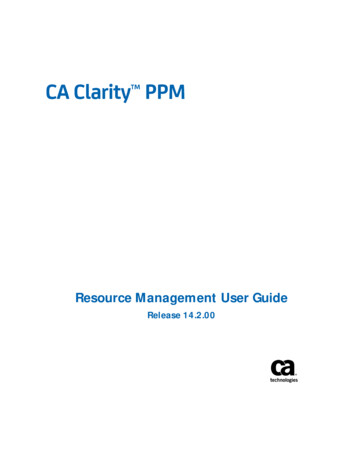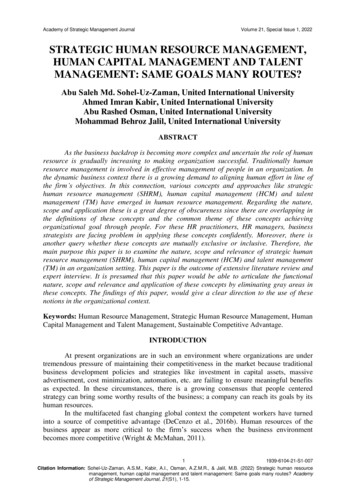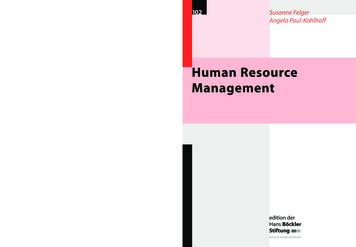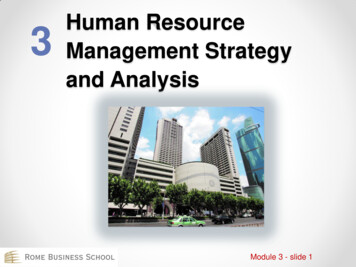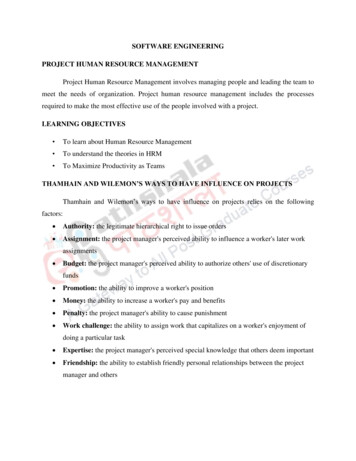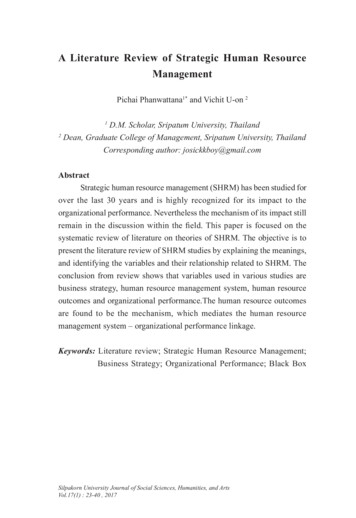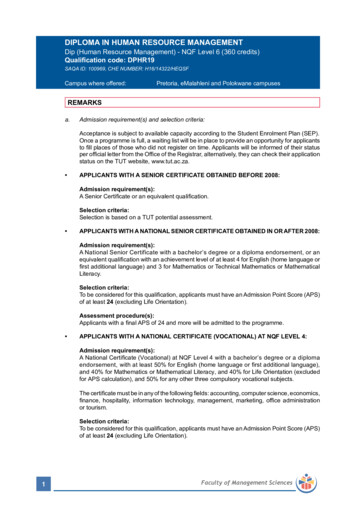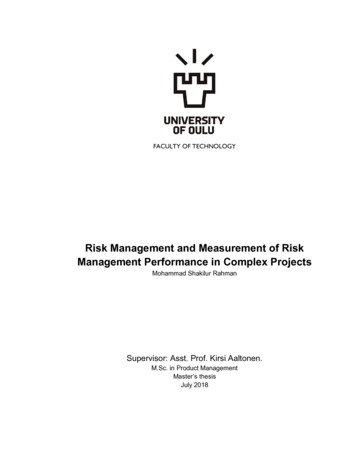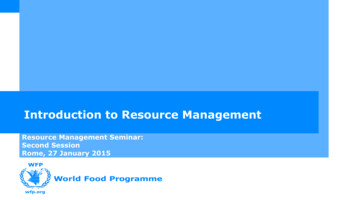
Transcription
Introduction to Resource ManagementResource Management Seminar:Second SessionRome, 27 January 2015
Agenda Second SessionWFP’s Financial Resource Management Planning Implementation Reporting Internal Controls Risk ManagementAnnex: RM Facts and FiguresResource Management Department11
WFP’s Financial Resource ManagementResource Management Department22
Guiding principles of Governance and ManagementWFP operates in a unique and challenging context100% voluntary fundingOperational uncertainty,difficult working environmentPrinciple of Full Cost RecoveryProject-based funding modelGlobal uncertainty of markets(currencies and commodity prices)United Nations and donorregulatory frameworksNew intervention types(e.g., Cash & Vouchers)Resource Management Department33
WFP’s Financial Resource Management6AnnualReports5Monitoring &Evaluation4Procure-toPay ning7Internal Control8 Risk ManagementResource Management Department44
Planning: Project Planning6AnnualReports5Monitoring &Evaluation4Procure-toPay ning7Internal Control8 Risk ManagementResource Management Department55
Planning: Project Budget PlansDescription:Project Budget Plans are:Prepared for all projectsProvide an estimate of requiredfunding Emergency Operations (EMOP)Protracted Relief and Recovery Operations (PRRO)Development Projects (DEV)Special Operations (SO) Budget plans for EMOPs and PRROs are needs drivenBudget plans for Development Projects are needs driven but must beimplementable with foreseen available resourcesApproval of a budget plan authorizes WFP to raise resources Form the foundation of theManagement Plan Three-year rolling Management Plan (MP) is approved duringExecutive Board’s 2nd Regular Session (yearly)MP presents aggregated projected operational requirements of allactive projects and foreseen logical extensionsAll projects are approved by the Executive Board or under the authority delegated to the Executive DirectorResource Management Department66
Planning: Project Budget StructureCost ComponentsToolsProject Budget StructureFoodCash & Vouchers (C&V)Capacity Development &Augmentation (CD&A)Food TransfersC&V TransfersCD&A TransfersExternal TransportLandside TransportationStorage and Handling(LTSH)Other DirectOperational Costs(ODOC) FoodC&V Related(includes Delivery andOther)Direct Support Costs (DSC)All contributions are subject to an Indirect Support Cost (ISC)Resource Management Department77
Planning: Contributions6AnnualReports5Monitoring &Evaluation4Procure-toPay ning7Internal Control8 Risk ManagementResource Management Department88
Implementation: Management Plan BudgetUSD million2015Operational Requirements perManagement Plan (MP)Actual Contribution RevenueProjected Contribution RevenueApproved Regular ProgrammeSupport and Administrative(PSA) budgetPSA Equalization 004,000281281256191*121WFP’s projected Operational Requirements for 2015 is USD 7.4 billion. Allcontributions are voluntary, and subject to internal controls.Resource Management Department*Preliminary figure99
Planning: Contributions and the Full Cost Recovery PrincipleFull Cost RecoveryPrinciple:RationaleAll contributions must cover their operational,direct support costs and indirect support costs Principle helps protect against cross-subsidization of support costs Ensures sustainability of support costs, both direct and indirect Principle is equitable towards all donors For indirect support costs, a set percentage rate serves as a driver of economy,efficiency, and effectiveness PossibleExemptionsCommodities/ Services from developing countries, countries in transitionaleconomies, and non-traditional donors (subject to further requirements) Resource Management DepartmentSome un-designated cash contributions1010
Planning: Contributions by Funding WindowMultilateralThree types of funding windows for contributions: Most flexible source of funding for WFP Allocated and prioritized by Strategic Resource Allocation Committee (SRAC)Proportion of funding:*8.1% Can be donated to the General Fund; the IRA; specific programme categories; and specificbroad-based appealsTrustFundsDirectedMultilateralImmediate Response Account (IRA): A form of multilateral contributions can be used as collateral Directed by donor to a specific WFP activity or country programme Standard Project Reports that are submitted to the Executive Board Used by donors to support bilateral country-level activities, or global initiatives Includes contributions for infrastructural needsTarget level: USD 200 million89.4%2.5%All contributions to WFP are voluntary. They can be in the form of monetary contribution, or in-kind contributions of foodcommodities; or goods and services.Resource Management Department*based on estimated 2014 figures1111
Planning: SRAC Prioritization for Multilateral ContributionsThe ‘Strategic Resource Allocation Committee’ (SRAC) process ensures thatmultilateral resources go to the most needy and impactful operationsAn evaluation of funding proposals is carried out based oncriticality and possible uation includes:Food security andseasonality,corporate/regionalattention, and GlobalHunger IndexEvaluation includes:8 month projectedfunding shortfallbased on pipelinesResource Management DepartmentPlacement onCriticality Matrix1212
Planning: Advance Financing6AnnualReports5Monitoring &Evaluation4Procure-toPay ning7Internal Control8 Risk ManagementResource Management Department1313
Planning: Two different financing needs within WFP Operationsi) Food Sourcing at best pricePlanProcurementKick-start FoodPurchase & DeliveryFooddelivered toregionRegional fundingforecast & foodneedsMeans: On-time delivery for beneficiariesFoodorderedReduced waitfor commoditiesii) Project Lending at right rdelivery tobeneficiariesSave lives throughefficient pipelinemanagementProvide collateralbased advancesWFP only begins spending when it has a pledge (this is called ‘forecasting on pledge’). If no pledge canbe confirmed, WFP uses Advance Financing.Resource Management Department1414
Planning: Third financing need within WFP is infrastructureInvestments for Vehicles, IT, Premises, etc.Single year PSAallocationsMismatchCosts, recoveries &benefits spread overyearsSolve mismatch throughCapital FinancingCapital Financing allows WFP to invest in infrastructure which provides recoveries and benefits over anumber of yearsResource Management Department1515
Planning: Advance Financing Tools in WFPWhat is funded?i) Food Sourcing at best priceRegional fundingforecast & foodneedsii) Project LendingProvide collateralbased anceFinancing(AF)What is the risk?What is funded?WFPUSD 350 millionFood lossesFoodinventorytUSD 570 millionForecasts notmaterializingForecastedprojectsWFPInvestments for Vehicles, IT, Premises,etc.Solve mismatchthrough CapitalFinancingResource Management DepartmentLoss of assetsCorporateServices(CS)USD 70 millionPlanned benefitsnot materializingCars, ITsystems, etc.1616
Planning: Working Capital Financing Facility (WCFF) andGlobal Commodity Management Facility utecommoditiesTotal ProcessTotal Process210DistributecommoditiesTotal tiesTime SavingsPotential 50 daysTime Savings Potential 100 daysWCFF and GCMF can reduce food delivery times by moving process steps in parallelResource Management Department1717
Implementation: Procure-to-Pay Process6AnnualReports5Monitoring &Evaluation4Procure-toPay ning7Internal Control8 Risk ManagementResource Management Department1818
Implementation: Procure-to-Pay (1)1. PurchaseCompetitiveRequestProcessInternal document torequest procurement offood commodities, goods orservicesSource of funding isidentified prior to creatingPurchase RequestResource Management Department2. FundsCertification3. CompetitiveProcessCertifying Officer atteststhe charge can berecorded against theproject or otherauthorization, and thatfunds are availableWFP makes purchasesthrough a competitivebidding process toguarantee that the bestprices are obtained andthat purchases are carriedout in a transparentmanner1919
Implementation: Procure to Pay cord final obligations anddocument WFP’s financialand legal commitments tospecific vendors.Resource Management Department5. Payments6. DisbursementsPhysical action of paying outmoney after all verifications,controls, approvals andauthorizations have beencarried out.WFP uses various methodof disbursement with thefollowing order topreference: from WINGSvia SWIFT, throughelectronic banking, bycheque, via UNPD or incash.2020
Reporting: Monitoring & Evaluation6AnnualReports5Monitoring &Evaluation4Procure-toPay ning7Internal Control8 Risk ManagementResource Management Department2121
Monitoring & Evaluation (M&E):Progress in strengthening monitoringDirect support to CO/RB Developmentofregionalmonitoringcapacityassessments and strategies; Training on the new Strategic Results Frameworkindicators in all regions, targeting all CO and RB M&Estaff; Launch of a M&E Learning Programme Funds to support monitoring activities at regional andcountry levels including USD 1.2 million for Regional M&EAdvisors; USD 900,000 in grants to 21 COs for strengthening ofoutcome measurement and reporting; Scale-up in the use of remote technologies in 10 ‘selfstarter’ countries; Full roll-out of COMET Design module and partial roll outof the Implementation module.Resource Management Department2222
Reporting: Annual Reports6AnnualReports5Monitoring &Evaluation4Procure-toPay ning7Internal Control8 Risk ManagementResource Management Department2323
Annual Reports: Financial Statements, SPR and APR The Annual Performance Report(APR) is the key corporate reportpresented to stakeholders, withinformationonWFP’sglobalperformanceFINANCIAL STATEMENTAPRSTANDARD PROJECT REPORTS1. Executive Director’s Statement other sources2. Statement on Internal Control3. Financial Statements I to V4. Notes to the Financial Statements5. External Audit Opinion and ReportResource Management Department It draws data from Standard ProjectReports (SPRs) as well as fromfinancial statements2424
Internal Control6AnnualReports5Monitoring &Evaluation4Procure-toPay ning7Internal Control8 Risk ManagementResource Management Department2525
Internal Control: WFP's Internal Control Framework serves as 'coathanger’ for all activities required for good management1.InternalEnvironment Ethical values Organizationstructure Strategicobjectives HR policies Managementstyle2. RiskManagement Identification ofthreats &opportunities Risk assessment Risk response3. ControlActivities Managementreview of actions Segregation ofroles inWINGS II IT systemspassword policy4. Information &Communication5. Monitoring Sharing ofrelevantinformation Informationescalation Timeliness &quality ofinformation Balancingsupervision µmanagement Periodic review ofsystems ReportingdeficienciesThe five components of Internal Control are used as framework for allInternal Control improvement toolsResource Management Department2626
Risk Management6AnnualReports5Monitoring &Evaluation4Procure-toPay ning7Internal Control8 Risk ManagementResource Management Department2727
Risk Management: Following the best-practice frameworkNew ERM policy (EB.A May 2015); and an Update of Risk Appetite statement (Q2 2015).Integration of oversight recommendations (second-line of defence); and ERM manualdeveloped (Q1 2015)Development of communication plans for ERM info (Q2 2015); Further integration of ERMcomponent into senior management trainings (Q2/Q3 2015)Revision of impact rating scale to allow for objective assessments (Q3 2015)Link assurances across three lines of defence to each corporate risk (deadline contingentupon finalization of assurance mapping exercise – Q3 2015)Revision of Corporate Risk Register/GRR format for EMG to accommodate Heat Map andrisk trends (Q2 2015); Continue inter-agency ERM work (incl. IASC co-chair on RM)Strategic discussions on Performance and Risk Organizational Management InformationSystem (PROMIS)Resource Management Department2828
Managing performance is everybody’s businessResource Management Department2929
WFP’s Financial Resource ManagementWithin the performance cycleResource Management Department3030
ANNEXResource Management Department3131
Annex: Financial Statements and External Audit documentsResource Management Department3232
Structure of WFP Financial Statements1. Executive Director’s Statement provides overview of:FINANCIAL STATEMENT Financial and Budget Highlights Enhancing Transparency and Accountability Enterprise Risk Management and Financial Risk Management2. Statement on Internal Control The Internal Control Framework and Enterprise Risk Management Review of the Effectiveness of Internal Control Significant Risk and Internal Control Matters3. Financial Statements I to V provide financial views on WFP’s operations.Key statements are: Statement I – states the financial position of WFP as of 31 December 2014 Statement II – states the financial performance of WFP for 2014 Statement V – compares WFP’s Actual performance against Budget4. Notes to the Financial Statements Disclose WFP’s accounting policies (Note 1) Provide explanatory detail to elements of the Financial Statements (Notes 2 – 12)5. External Audit Opinion and ReportResource Management Department3333
Statement of Financial Performance (USD millions)2014 6.7156.2167.1139.6Total tion revenue (monetary and inkind)Other (Other Revenue, Currency and Returnon Investment)Surplus (Deficit)Cash & Voucher (C&V) expense over the years2014201320122011C&V expense844.7498.1191.8120.7Annual growth170%260%159%200%Total expenses5,121.64,514.84,395.74,016.8Resource Management Department3434
Overview of Statement on Internal Control2014 is the 4th year for which a ‘Statement on Internal Control’ will be produced Global best practice to assure stakeholders and demonstrate accountability To be signed by the ED and published with Annual Financial Statements (May 2015)Directors were required to submit an “Assurance Statement” on internal control for theirOffice/Division to form the primary basis of ED Statement DED/AEDs and RDs reviewed and cleared the responses provided by Departments/Offices reporting to themOther evidences consideredAll directors within WFP to submit Assurance Statement for their geographic or functional areaof responsibilityAnalysis indicates progress in strengthening internal control systems within WFP compared tolast year, but there are still areas for improvement Issue on segregation of duties significantly improved and related high risk Internal Audit recommendation closedOther four areas previously reported on (risk management, Emergency Preparedness and Response Package,PACE and M&E) continue to need further improvement actionsResource Management Department3535
External AuditExternal Auditor is appointed by the Executive BoardThe Comptroller and Auditor General of India has been appointedfor July 2010 - June 2016 termEach year, the External Auditor conducts:Two PerformanceAudits on topics inconsultation withManagementAudit of theFinancialStatementsManagement preparesa progress report onoutstanding ExternalAudit recommendationsPresented at the Annual Board Session in JuneResource Management Department3636
Introduction to Resource Management Resource Management Seminar: Second Session Rome, 27 January 2015. Resource Management Department 1 1 Agenda Second Session . Total Process 0 30 60 90 120 150 180 210 Days Distribute commodities Total Process Distribute commodities Total Process Distribute commodities Time Savings Potential



